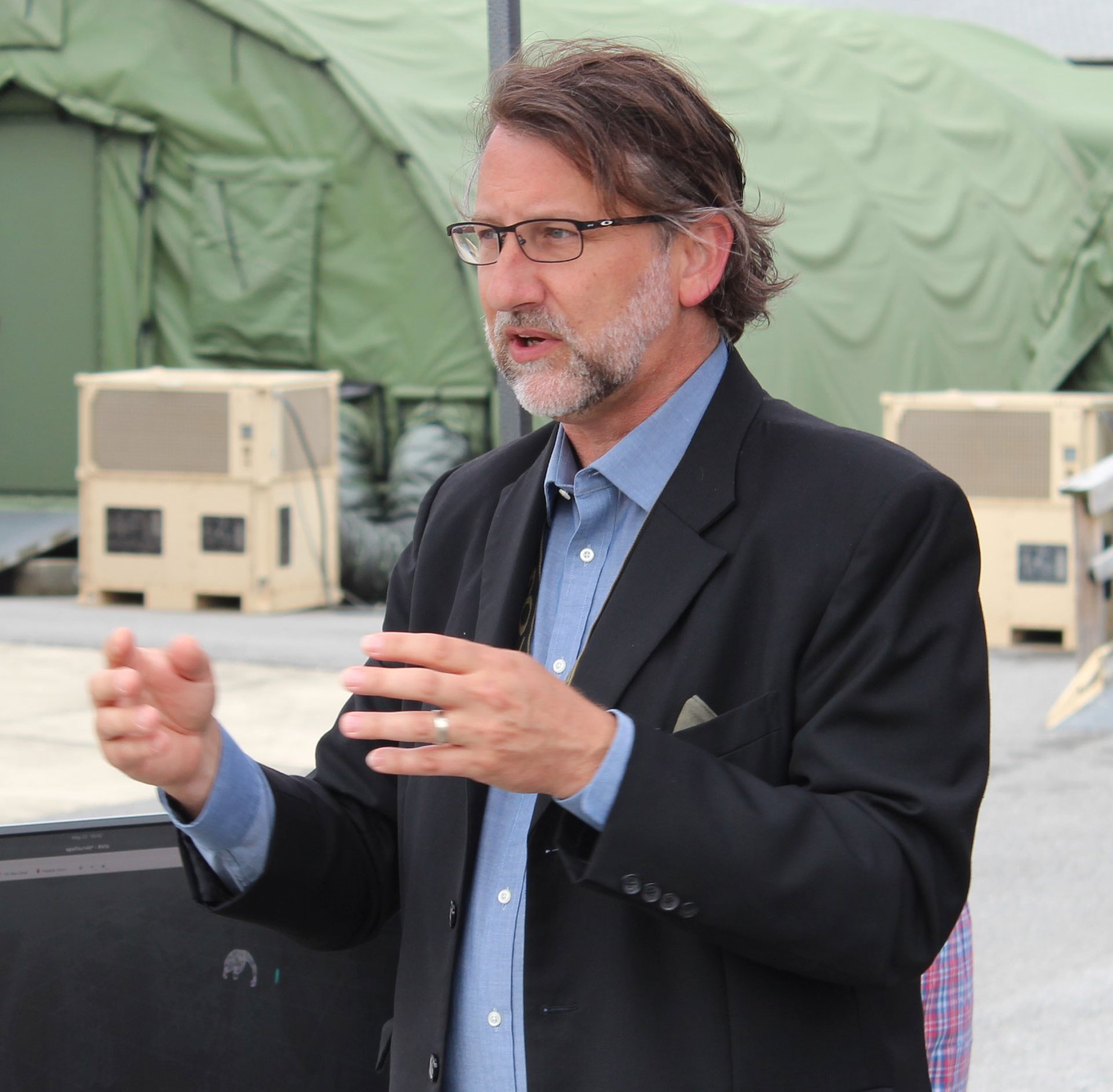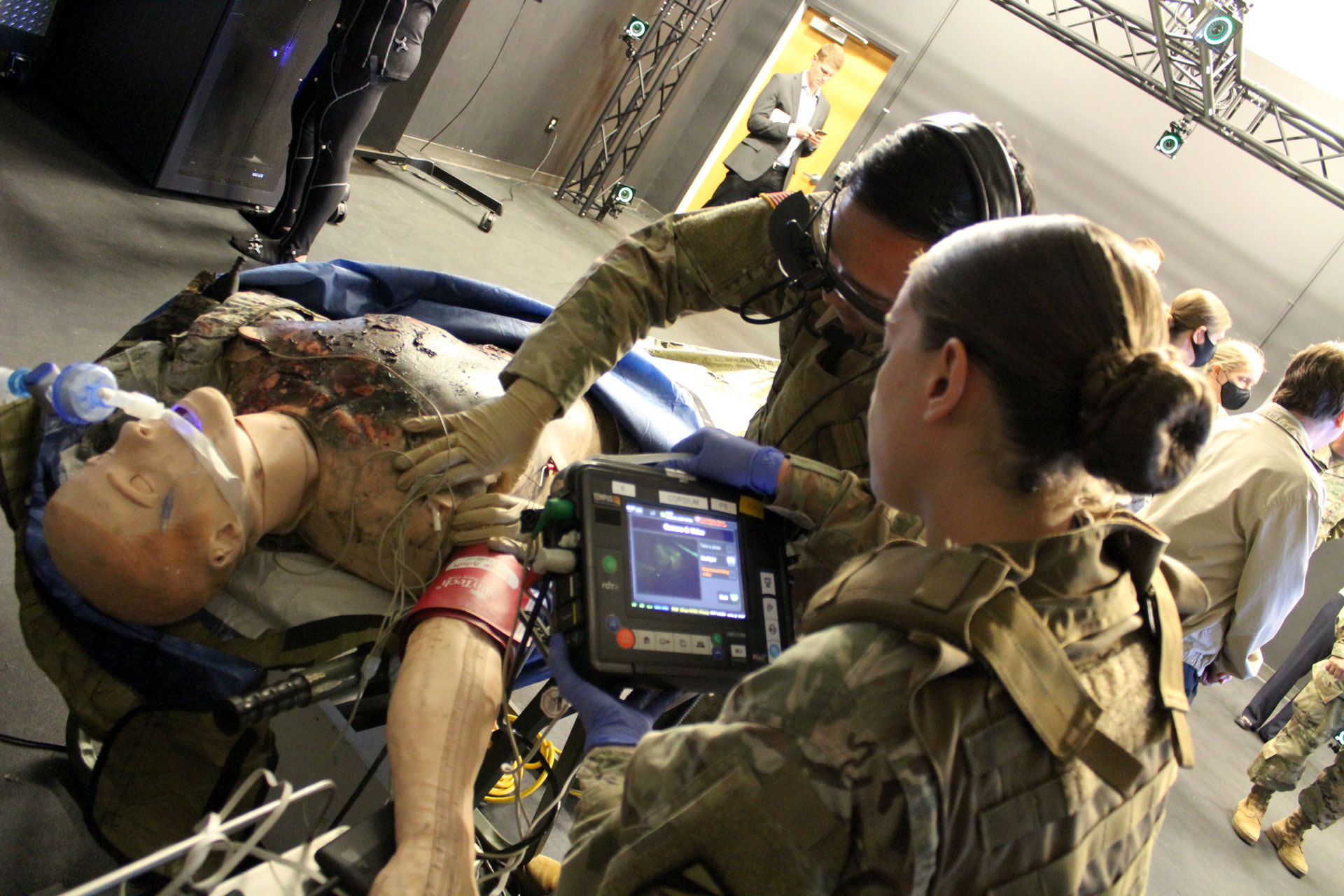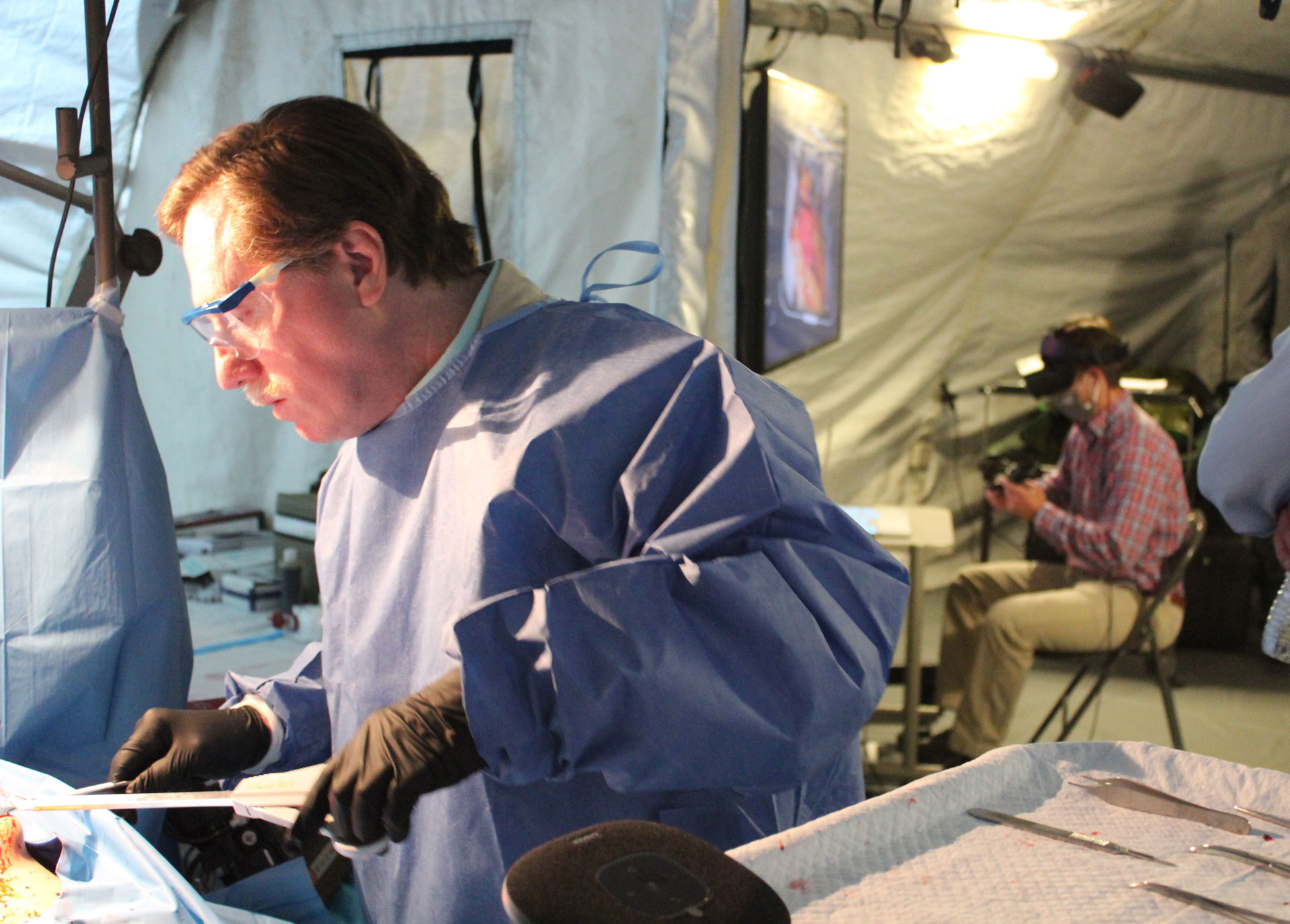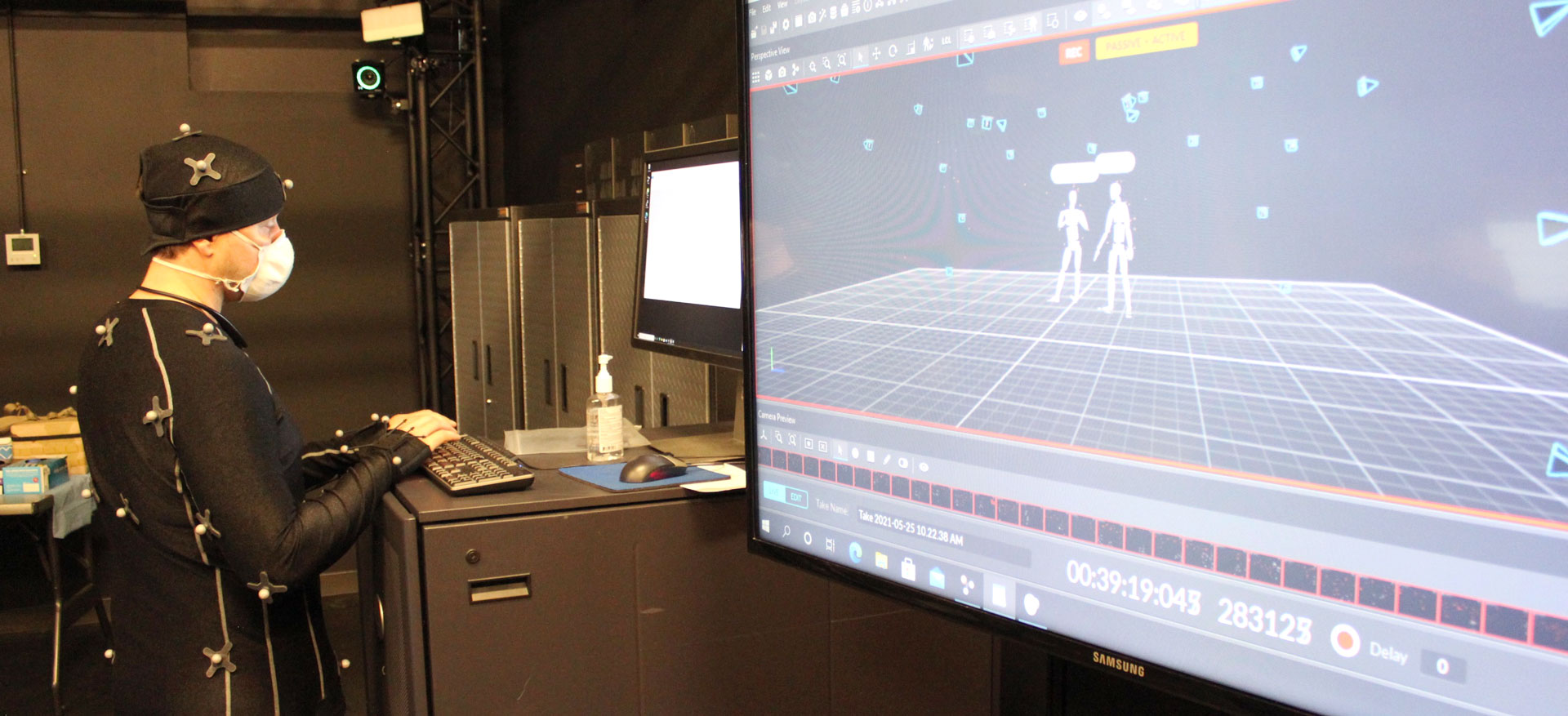
DIGITAL MEDICINE: A Soldier relays information via a cell phone during an exercise on the TATRC grounds, to highlight the capabilities of the NEXUS laboratory on May 25.
NEXUS Laboratory charts the future of medical performance.
by Ramin A. Khalili
It starts with chaos and so everyone acts accordingly. The Soldier picks up his radio and calls for air support—then motions to a buddy, who helps him carry an injured squad member about 50 yards away, setting up shop behind a barely-there wall of concrete blocks. There’s yelling, of course—more like screaming, constant motion. Another Soldier runs over to help and now all three are busy administering combat casualty care to the person laying on the ground between them.
Standing just a few feet away, monitoring the action via computer, is Geoffrey Miller—who serves as the division chief of the Medical Modeling, Simulation, Informatics, and Visualization program at the U.S. Army Medical Research and Development Command’s (USMRDC) Telemedicine and Advanced Technology Research Center (TATRC). Just as the action hits a crescendo, Miller turns to a nearby crowd and says, “What we’re really trying to understand here is what kind of data matters in any given situation.”
“Any questions?” he says casually.

DATA STAR: Geoffrey Miller, division chief for the Medical Modeling, Simulation, Informatics, and Visualization program at TATRC, spoke to a group of Soldiers and scientists during a tour of the NEXUS lab on May 25. Miller wants to provide everyone with the expertise they need through the science of data. (Photos by Ramin A. Khalili, USAMRDC Public Affairs)
If you haven’t guessed by now, the Soldiers described here are engaged in a training scenario. Their efforts—and indeed the entire simulation taking place in the TATRC parking lot on this sunny morning in late May; from the medical equipment in the nearby tents to the scientists wearing motion-capture suits in the foam-padded studio just yards away—is part of a planned tour of USAMRDC’s new NEXUS laboratory; a next-generation research environment designed to explore and analyze the intersection of humans, data and technology across the Military Health System. But it’s the end result of all that data collection—the overall impact that this newly-christened laboratory can truly, ultimately provide—that has heads turning at USAMRDC and beyond.

MEDIC!: NEXUS laboratory researchers monitor Soldiers as they carry a wounded “casualty” to a new location on the TATRC grounds during an exercise on May 25.
THE RIGHT DATA
The NEXUS laboratory is, as the name surely implies, a sleek and high-tech medical performance measurement laboratory; one that ultimately seeks to record military medical professionals as they perform various medical tasks (both with and without certain medical devices and technologies) in order to better understand human clinical procedural performance. The ultimate goal is then the codification of that performance.
“We like to talk a lot about the reliability of data, but I like to talk about the feasibility and practicality of data, too,” said Miller, who began his career as a paramedic—logging 31 years on the job, in fact—before stepping into his current role at USAMRDC. “What’s the right piece of data at the right time that’s going to help make the right decision?”
If that’s the question, then the NEXUS laboratory is indeed primed to find an answer, as it combines such cutting-edge tools as volume capture technology (a technique that digitizes three-dimensional spaces), psychophysiological monitoring (including sensors to document skin sweating and blood pressure), and electromagnetic motion tracking (a technology that allows human movement to be followed and then gathered and processed), among others, to develop a so-called “master model of performance” as it pertains to any given medical procedure—a process Miller likes to call “finding out what ‘right’ looks like.” Once that baseline is achieved, the plan is to then train current and future medical professionals off of that new, master standard.
“Everybody’s heard the old adage [that] practice makes perfect, but that’s one hundred percent not true,” said Miller. “Practice makes permanent, because if your practice is imperfect, you will be permanently imperfect.”
TEN PERCENT
The NEXUS laboratory hopes to shore up those imperfections in a number of ways, chiefly by employing its capabilities to monitor both the physical and psychological efforts of its participants—including medics and other military medical personnel—performing various tasks related to combat casualty care. For instance, by monitoring physiological responses such as heart rate, blood pressure, respiratory response and electrodermal activity (i.e., sweat production) to a range of efforts—anything from establishing an airway to applying a tourniquet—researchers can then quantify and describe actions in which those aforementioned “master performers” excel—and, conversely, quantify those in which novice performers do not excel. Additionally, by using an electroencephalogram, or EEG, to measure the electrical activity of the brain during a given task, researchers can objectively measure the cognitive load of said task on any participant; information that could, in turn, allow researchers to pinpoint when a particular Soldier is experiencing heavier stress and, additionally, which specific tasks caused that stress.
Further, and as a more specific example, the laboratory’s motion capture system allows researchers to begin the process of finding answers to how, exactly, medical professionals must position their owns bodies to perform a particular procedure—everything from intubation to performing chest compressions—at an expert level.

CAPTURED CARE: Two Soldiers perform routine medical care on a mannequin in the NEXUS laboratory’s motion capture studio while their actions are recorded using cameras and sensors.
“How someone lays out their equipment to prepare for a surgery or a procedure may be significant, or it may not matter, but we don’t know until we explore that, until we measure it,” said Miller. For instance, and as Miller described it, if 50 percent of medics always put their instruments in a certain order for a certain procedure, and those medics are then able to perform that procedure with a 10 percent better efficiency than the medics who put their instruments in a different order—does that 10 percent time savings ultimately impact the casualty? For Miller and the team at TATRC, we simply won’t know unless we record the data and crunch the numbers.
According to Miller, “These are the questions we’re hoping to explore and understand, because if we realize we got one hundred percent of people to save that 10 percent, then it could make care 10 percent better in the long run.”
In short, Miller said, the ultimate goal of collecting such voluminous data is for the expertise to be transferred from a single person (or a single “master performer”) to the modeling itself, which can then be inserted into other computer-based systems to allow any student to practice independently with expert feedback, guidance and assessment.

REMOTE INSTRUCTION: A NEXUS laboratory tour participant, left, completes a complex surgical task while a scientist instructs him on how to perform said task from another room, while wearing virtual reality goggles.
These capabilities are in turn important to the larger Army modernization strategy as both the Army and DOD begin to capture, process and apply that collected data for the purposes of accomplishing overmatch on the multi-domain battlefield. According to military experts, future adversaries will likely have spent years studying previous U.S. military processes and procedures—or, more specifically, how exactly the U.S. military approaches and engages in combat. In the face of this likely reality, the NEXUS laboratory positions itself as integral to the overall USAMRDC and DOD missions, as maximizing Soldier readiness—in this case, via data collection—may ultimately translate to increased Soldier lethality.
“Our intent here is to take all the data we’re collecting and whittle it down to the data that’s going to help the caregiver,” said Col. Jeremy Pamplin, the director at TATRC since August 2018, commenting on the laboratory and its capabilities. “If we can figure out the best technique as supported by data, regardless of what the prevailing opinion is, then we can take that information to the [Food and Drug Administration], to our partners in industry.”
In a quip that essentially sums up the entire purpose of the NEXUS laboratory, Miller said, “Basically we’ve democratized expertise for any trainee, anywhere.”

NICE SUIT: A Soldier wearing a motion capture suit surveys data in the NEXUS laboratory while the screen records his movements.
TWIN PILLARS OF THE FUTURE
Given the outsize role technology will likely play on the future battlefield—and indeed, perhaps reflecting the outsize role it plays in all our daily lives—the NEXUS laboratory is further designed to test human interaction with modern medical technology in order to discern if such tools truly benefit the caregiver—and, in turn, the person receiving care.
“What we’re doing here is testing these technologies in actual environments that simulate what Soldiers would see on the battlefield,” said Nate Fisher, chief of TATRC’s Medical Robotics and Autonomous System Division.
As part of the aforementioned focus on the multi-domain battlefield of the future, recent military medical research efforts have focused almost exclusively on two areas: making key tools and technologies smaller and studier, and finding ways to employ the substantial gains being made in the field of artificial intelligence. The NEXUS laboratory team hopes to put both of those efforts under the microscope. From the perspective of the team at TATRC, efforts to study these emerging technologies in such a unique setting will eventually allow researchers to more quickly identify the products likely to help caregivers complete their mission—a factor of chief importance when faced with the constraints of austere and operational environments. As a result, the NEXUS laboratory offers the ability to inform the development of better tools and technologies at a much faster rate than the current research and development process.
“We come here, we push [the product] to the point of failure, then figure out how we can make it better,” said Miller. “And so when it comes to project convergence, we now have a more mature product to test in the larger medical battlefield ecosystem.”

VIGILANT: A Soldier monitors the health of a “casualty” inside a model of an unmanned vehicle during a tour of the TATRC NEXUS laboratory on May 25.
CONCLUSION
In moments of candor—and perhaps as a means to simplify the complexities behind such vast data collection—Miller is keen to compare the mission of the NEXUS laboratory to something far more familiar: the game of baseball. Indeed, baseball teams and their respective scouts have been gathering data on chosen prospects for decades, calculating everything from the speed at which a player swings a bat to how much energy a player exerts when stealing a base. And still, while baseball has yet to find a find a way to use that data to create the perfect ballplayer—the player who can approach each challenge in the most precise and efficient way possible—Miller believes the NEXUS laboratory may be able to do just that when it comes to teaching future generations of caregivers.
“We’ve modeled what ‘expert’ looks like,” said Miller, “so now let’s give that expertise to everybody.”
For more information about USAMRDC, go to https://mrdc.amedd.army.mil/; for more information about TATRC, go to https://www.tatrc.org.
RAMIN KHALILI is a writer with USAMRDC’s Public Affairs Office. Before assuming his current role, he spent five years as the knowledge manager for USAMRDC’s Combat Casualty Care Research Program. During his previous work as a broadcast journalist, he earned an Associated Press Award for his work in Phoenix, Arizona, before serving as chief NASA correspondent for CBS in Orlando, Florida. He holds a B.A. in communications from Penn State University.







